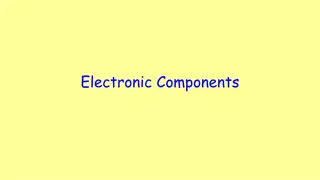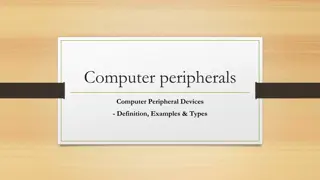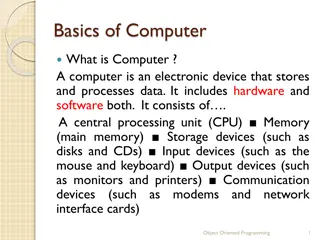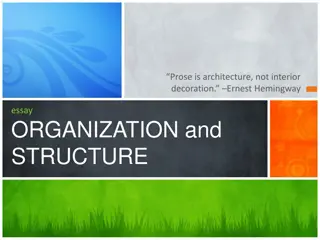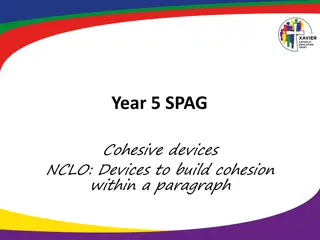Understanding Cohesive Devices in Writing
Cohesive devices such as adverbials, determiners, and pronouns play a crucial role in creating a flow in writing. By organizing adverbials into groups based on where, when, how, and how often they describe actions, writers can enhance the clarity and coherence of their texts. Additionally, recognizing and utilizing cohesive devices like determiners and pronouns helps avoid repetition and ensures smooth transitions between ideas, ultimately improving the overall quality of writing.
Download Presentation

Please find below an Image/Link to download the presentation.
The content on the website is provided AS IS for your information and personal use only. It may not be sold, licensed, or shared on other websites without obtaining consent from the author. Download presentation by click this link. If you encounter any issues during the download, it is possible that the publisher has removed the file from their server.
E N D
Presentation Transcript
Warm up Warm up Can you group theses adverbials into the following groups: Where? Place. When? Time. How? Manner. How often? Frequency. Slowly Regularly At 9:00pm In the distance Often Down the road Hesitantly Whilst I brush my hair Every day Every time the doorbell rings However hard I tried Loudly
Warm up Warm up Where? Place. When? Time. How? Manner. How often? Frequency. Slowly Regularly At 9:00pm In the distance Often Down the road Hesitantly Whilst I brush my hair Every day Every time the doorbell rings However hard I tried Loudly
LO: To identify and use a range of LO: To identify and use a range of cohesive devices cohesive devices Steps to success: I can - Name types of cohesive device (toolkit) - Identify used cohesive devices in a piece of writing - Improve a text by adding appropriately chosen cohesive devices
Discuss these question with your partner: Discuss these question with your partner: What is cohesion? How can we tell if something is cohesive? How do we achieve it? What are cohesive devices? Can you think of any examples? What makes out writing cohesive?
Determiners Determiners Determiners specify which noun(s) we are talking about. E.g. the, a, an, some, several, all of the, one, many, no, either Determiners are perhaps the most simplest form of cohesive devices. Without them, our writing does not flow very well. E.g. Dog bit man because dog was angry. Man shouted at dog. Dogs came around corner and chased men away. A dog bit a man because the dog was angry. The man shouted at the dog. Several dogs cam around the corner and chased the men away.
Pronouns Pronouns Pronouns can act as a noun phrase. E.g. he, she, it, they, them, we, theirs, itself, themselves, us, anybody Relative pronouns are used to form relative clauses E.g. who, that, whom, whose, which We use pronouns to avoid over repetition of nouns. E.g. The man was shopping at the supermarket. The man decided to buy some cheese. However, when the man got home, the man found out that the cheese was out of date. Finding out that the cheese was out of date made the man very sad. The man was shopping at the supermarket. He decided to buy some cheese. However, when he got home he found out it was out of date. This made him very sad.
Conjunctions Conjunctions Conjunctions join clauses together within a sentence. Co-ordinating conjunctions For, and, nor, but, or, yet, so Subordinating conjunctions because, although, while, since, even though, if, whereas, provided, before, after By joining our clauses together, we are able to vary our sentences and add more cohesion to our writing. E.g. The girl hated winter. She could not stand the cold. The girl hated winter because she could not stand the cold.
Adverbial Adverbial Adverbials typically add detail to the verb by describing where, when, how or how often the action occurs. E.g. Occasionally, in the dark, aggressively, frequently Adverbials can be adverbs, adverbial phrases or adverbial clause Fronted adverbials are an effective way to create cohesion Some adverbials don t fit into where , when , how , how often categories. These adverbials will often refer be referring to the previous sentence and are particularly effective at creating cohesion. These adverbials can show exceptions, cause & effect, comparison, clarification, emphasis E.g. However, furthermore, alternatively, consequently, because of this, in conclusion, in other words, also, most importantly,
Ellipses Ellipses Omission of words or sentences which are implied , or where the meaning of the sentence is maintained. Usually represented by a series of three dots - . Ellipses can be used cohesively by allowing us to clearly show interruptions (often in speech). E.g. Harry looked slightly confused, How do you It s on the front cover! Hermione interrupted suddenly. Cliff-hangers (to imply missing information) E.g. He stepped forwards Where words are not included (to avoid repetition) E.g. Do you want go to the park or [do you want to] go out tonight. In response to a question Why did the chicken cross the road? [The chicken crossed the road] to get to the other side.
Paragraphing Paragraphing Using paragraphs carefully and concisely allows us to create cohesion. If our paragraphs are too long or too short, it can make our writing less cohesive We start a new paragraph when we: Start a new topic or idea Significant change in time Change in viewpoint New speaker Significant change in place
Wide range of vocabulary Wide range of vocabulary By choosing precise vocabulary, we can make our writing more cohesive. Over repetition of the same words particularly adjectives - can make our writing appear clumpy . Just like the use of pronoun, using synonyms will help the flow of our writing However, it is important to remember that using lots of similar adjectives to describe the same noun can also have a negative impact on our writing. On the other hand, we can often repeat particular words and phrases for emphasis.






